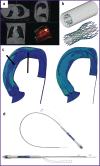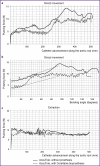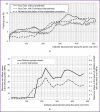Mechanism of Vascular Injury in Transcatheter Aortic Valve Replacement
- PMID: 34603750
- PMCID: PMC8482820
- DOI: 10.17691/stm2021.13.3.01
Mechanism of Vascular Injury in Transcatheter Aortic Valve Replacement
Abstract
The aim of the study was to determine the potential mechanism of vascular complications due to "catheter-vascular wall" interaction in transcatheter aortic valve replacement using experimental and numerical analysis.
Materials and methods: A series of full-scale bench tests and numerical simulations were carried out using the CoreValve commercial transfemoral delivery system for aortic valve bioprosthesis (Medtronic Inc., USA). Full-scale tests were carried out using a phantom of the vascular system (a polymeric silicone model of Transcatheter Aortic Valve; Trandomed 3D Inc., China) with simulation of all stages of delivery system movement along the vascular bed. They involved introduction into the common femoral artery, movement along the abdominal and thoracic parts of the aorta, the aortic arch, and positioning the system to the implantation site. The force arising from the passage of the delivery system was assessed using sensors of a Z50 universal testing machine (Zwick/Roell, Germany). Numerical simulation of transcatheter valve replacement procedure was carried out in a similar way with allowance for the patient-specific anatomy of the recipient's aorta using the finite element method in the Abaqus/CAE environment (Dassault Systèmes, France).
Results: It was found that in the process of the delivery system passing through the vascular system, there occurred force fluctuations associated with catheter bending and its interaction with the aortic wall in the region of its arch. For example, in the initial straight portions, the pushing force was 3.8-7.9 N; the force increased to the maximum (11.1 and 14.4 N with and without the prosthesis) with bending of the distal portion of the catheter. A similar increase was observed when performing numerical simulation with high-quality graphic visualization of stress on the "spots" of contact between the catheter and the vascular wall with an increase in stress to 0.8 MPa.
Conclusion: Numerical and full-scale bench tests prove the significant effect of the properties of delivery system catheter for transcatheter aortic valve replacement on the interaction with the aortic walls.
Keywords: aortic valve; finite element method; the delivery system of TAVR bioprosthesis; transcatheter valve replacement.
Conflict of interest statement
Conflicts of interest. There are no conflicts of interest related to this study.
Figures






Similar articles
-
Direct aortic transcatheter valve implantation via mini-thoracotomy using the Medtronic CoreValve.Multimed Man Cardiothorac Surg. 2013;2013:mmt015. doi: 10.1093/mmcts/mmt015. Multimed Man Cardiothorac Surg. 2013. PMID: 24448561
-
Comparison of Self-Expanding Bioprostheses for Transcatheter Aortic Valve Replacement in Patients With Symptomatic Severe Aortic Stenosis: SCOPE 2 Randomized Clinical Trial.Circulation. 2020 Dec 22;142(25):2431-2442. doi: 10.1161/CIRCULATIONAHA.120.051547. Epub 2020 Oct 15. Circulation. 2020. PMID: 33054367 Clinical Trial.
-
Successful Transfemoral Transcatheter Aortic Valve Replacement in a Patient with Double Aortic Arch: An Interesting Imaging Case.Cardiology. 2021;146(1):85-87. doi: 10.1159/000509930. Epub 2020 Sep 21. Cardiology. 2021. PMID: 32957102
-
Alternative transarterial access for CoreValve transcatheter aortic bioprosthesis implantation.Expert Rev Med Devices. 2015 May;12(3):279-86. doi: 10.1586/17434440.2015.1005605. Epub 2015 Feb 11. Expert Rev Med Devices. 2015. PMID: 25672856 Review.
-
Transcatheter Aortic Valve-in-Valve Procedure in Patients with Bioprosthetic Structural Valve Deterioration.Methodist Debakey Cardiovasc J. 2017 Jul-Sep;13(3):132-141. doi: 10.14797/mdcj-13-3-132. Methodist Debakey Cardiovasc J. 2017. PMID: 29743998 Free PMC article. Review.
References
-
- Hellhammer K., Piayda K., Afzal S., Kleinebrecht L., Makosch M., Hennig I., Quast C., Jung C., Polzin A., Westenfeld R., Kelm M., Zeus T., Veulemans V. The latest evolution of the Medtronic CoreValve system in the era of transcatheter aortic valve replacement. JACC Cardiovasc Interv. 2018;11:2314–2322. doi: 10.1016/j.jcin.2018.07.023. - DOI - PubMed
-
- Ojeda S., Hidalgo F., Romero M., Mazuelos F., Suárez de Lezo J., Martín E., Lostalo A., Luque A., González R., Fernández A., López-Aguilera J., Segura J., Guerrero N., Pan M. Impact of the repositionable Evolut R CoreValve system on the need for a permanent pacemaker after transcatheter aortic valve implantation in patients with severe aortic stenosis. Catheter Cardiovasc Interv. 2020;95(4):783–790. doi: 10.1002/ccd.28327. - DOI - PubMed
-
- Dandeniyage L.S., Adhikari R., Bown M., Shanks R., Adhikari B., Easton C.D., Gengenbach T.R., Cookson D., Gunatillake P.A. Morphology and surface properties of high strength siloxane poly(urethane-urea)s developed for heart valve application. J Biomed Mater Res B Appl Biomater. 2019;107(1):112–121. doi: 10.1002/jbm.b.34101. - DOI - PubMed
Publication types
MeSH terms
LinkOut - more resources
Full Text Sources
